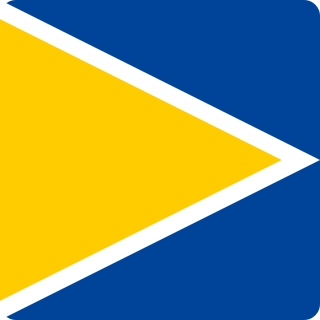
Traffic lights, traffic signals, or stoplights – also known as robots in South Africa – are signalling devices positioned at road intersections, pedestrian crossings, and other locations in order to control flows of traffic.

A railway signal is a visual display device that conveys instructions or provides warning of instructions regarding the driver’s authority to proceed. The driver interprets the signal's indication and acts accordingly. Typically, a signal might inform the driver of the speed at which the train may safely proceed or it may instruct the driver to stop.

Railway signalling (BE), also called railroad signaling (AE), is a system used to control the movement of railway traffic. Trains move on fixed rails, making them uniquely susceptible to collision. This susceptibility is exacerbated by the enormous weight and inertia of a train, which makes it difficult to quickly stop when encountering an obstacle. In the UK, the Regulation of Railways Act 1889 introduced a series of requirements on matters such as the implementation of interlocked block signalling and other safety measures as a direct result of the Armagh rail disaster in that year.

Part of a railway signalling system, a train stop, trip stop or tripcock is a train protection device that automatically stops a train if it attempts to pass a signal when the signal aspect and operating rules prohibit such movement, or if it attempts to pass at an excessive speed.

Cab signaling is a railway safety system that communicates track status and condition information to the cab, crew compartment or driver's compartment of a locomotive, railcar or multiple unit. The information is continually updated giving an easy to read display to the train driver or engine driver.

Automatische TreinBeïnvloeding or ATB is a Dutch train protection system first developed in the 1950s. Its installation was spurred by the Harmelen train disaster of 1962.

The railway signalling system used across the majority of the United Kingdom rail network uses lineside signals to control the movement and speed of trains.
Australian railway signalling varies between the States of Australia, because the individual States are were responsible for the railway systems within their own borders, with, historically, no need to co-ordinate between states except at the boundaries.

Transmission Voie-Machine is a form of in-cab signalling originally deployed in France and is mainly used on high-speed railway lines. TVM-300 was the first version, followed by TVM-430.
Railway signals in Germany are regulated by the Eisenbahn-Signalordnung. There are several signalling systems in use, including the traditional H/V (Hauptsignal/Vorsignal) system.
The Canadian Rail Operating Rules is a set of operating rules for railways in Canada. It is used by every Canadian railway.

Railway semaphore signal is one of the earliest forms of fixed railway signals. This semaphore system involves signals that display their different indications to train drivers by changing the angle of inclination of a pivoted 'arm'. Semaphore signals were patented in the early 1840s by Joseph James Stevens, and soon became the most widely used form of mechanical signal. Designs have altered over the intervening years, and colour light signals have replaced semaphore signals in most countries, but in a few they remain in use.
The current French railway signalling system is in force on the Réseau Ferré de France since 1930, when the code Verlant was applied.
Transmission balise-locomotive (TBL) is a train protection system used in Belgium and on Hong Kong's East Rail line.
Swiss railway signalling describes the railway signalling systems used in Switzerland by the different railway companies. There are two main types of signal, used up to 160 km/h, above which speed cab signalling is required.

The Italian railway signalling currently in use, employed on the Italian national railway network, is regulated by the "Regulation on signals", issued by the Italian railway infrastructure manager, RFI.
Belgian railway signalling is the signalling in effect on the Belgian rail network currently operated by Infrabel.

Stavoren is a terminus railway station in Stavoren, Netherlands. The station opened on 28 November 1885 and is the southern terminus of the Leeuwarden–Stavoren railway. Train services are operated by Arriva.
The Polish (PKP) railway signalling system provides a complex outlook of traffic situations, yet is quite easy to understand. Signals can be divided into following categories:

On 21 April 2012 at 18:30 local time, two trains were involved in a head-on collision at Westerpark, near Sloterdijk, in the west of Amsterdam, Netherlands. Approximately 117 people were injured, one of whom later died in hospital. The collision is thought to have been caused by the driver of one of the trains passing a red signal.
This page is based on this
Wikipedia article Text is available under the
CC BY-SA 4.0 license; additional terms may apply.
Images, videos and audio are available under their respective licenses.













